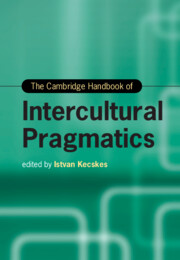Book contents
- The Cambridge Handbook of Intercultural Pragmatics
- Cambridge Handbooks in Language and Linguistics
- The Cambridge Handbook of Intercultural Pragmatics
- Copyright page
- Contents
- Figures
- Tables
- Acknowledgment
- Contributors
- Introduction The Rise of Intercultural Pragmatics
- Part I Theoretical Foundation
- Part II Key Issues in Intercultural Pragmatics Research
- Part III Interface of Intercultural Pragmatics and Related Disciplines
- 15 Semiotics and Intercultural Pragmatics
- 16 Sociopragmatics and Intercultural Interaction
- 17 Intercultural Pragmatics from the Perspective of English as a Lingua Franca
- 18 Intercultural Rhetoric
- 19 Politeness and Rapport Management
- 20 Corpus Pragmatics: Corpus-Based Intercultural Pragmatic Research
- Part IV Intercultural Pragmatics in Different Types of Communication
- Part V Language Learning
- Index
- References
18 - Intercultural Rhetoric
from Part III - Interface of Intercultural Pragmatics and Related Disciplines
Published online by Cambridge University Press: 29 September 2022
- The Cambridge Handbook of Intercultural Pragmatics
- Cambridge Handbooks in Language and Linguistics
- The Cambridge Handbook of Intercultural Pragmatics
- Copyright page
- Contents
- Figures
- Tables
- Acknowledgment
- Contributors
- Introduction The Rise of Intercultural Pragmatics
- Part I Theoretical Foundation
- Part II Key Issues in Intercultural Pragmatics Research
- Part III Interface of Intercultural Pragmatics and Related Disciplines
- 15 Semiotics and Intercultural Pragmatics
- 16 Sociopragmatics and Intercultural Interaction
- 17 Intercultural Pragmatics from the Perspective of English as a Lingua Franca
- 18 Intercultural Rhetoric
- 19 Politeness and Rapport Management
- 20 Corpus Pragmatics: Corpus-Based Intercultural Pragmatic Research
- Part IV Intercultural Pragmatics in Different Types of Communication
- Part V Language Learning
- Index
- References
Summary
Intercultural rhetoric and intercultural pragmatics are two linguistically based fields with many principles and processes in common: both examine the use of language systems in encounters between people with different L1s, coming from different cultures, but communicating in a common language. This chapter provides an overview of intercultural rhetoric highlighting the ways in which intercultural pragmatics and intercultural rhetoric parallel and complement one another. The chapter begins with a description of the evolution of intercultural rhetoric from contrastive rhetoric drawing particular attention to the shift to understanding culture dynamic, understanding the importance of analyzing texts in context, and drawing greater attention to the use of negotiation and accommodation. The chapter then explores the influences that intercultural rhetoric and intercultural pragmatics have exerted on English for Specific Purposes, English for Academic Purposes, and second language teaching, particularly noting the ways the two fields have complemented and paralleled one another and suggesting ways the fields can serve as a bridge across chasms that have formed in linguistics, second language writing, English as a Lingua Franca, and translingualism. The chapter ends with a short discussion of the future of intercultural rhetoric and suggestions for future trends.
- Type
- Chapter
- Information
- The Cambridge Handbook of Intercultural Pragmatics , pp. 469 - 483Publisher: Cambridge University PressPrint publication year: 2022



